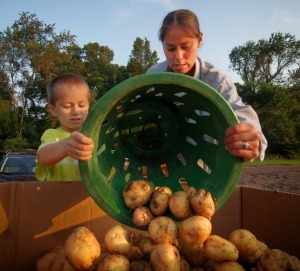Gleaning for Good

Though months have passed since Farm to Food Bank Program Coordinator Amy Cawley gleaned the last of the harvest season’s turnips, kale, collard greens, and cabbage from our farm partners’ fields, her work has not ended. While she won’t pick crops again until the end of May, when the first of this year’s strawberries have ripened, Cawley and her staff are using the cold-weather months to focus on one goal in particular: recruiting more volunteers.
“We’ve reached out to school boards and made a list of religious organizations we need to hit next,” Cawley said. “We’re looking to recruit within Future Farmers of America and 4H clubs, as well as businesses and the colleges nearby.”
Since 2010, the Maryland Food Bank’s Farm to Food Bank Program has engaged farms across the state in a partnership that increases access to fresh fruits and vegetables for our food-insecure neighbors.
Farmers either donate excess crops, commit to growing produce for the food bank, or allow our volunteers to glean what remains in their fields after harvest. Produce is then distributed through the MFB’s network of partners and our Pantry on the Go mobile drops.
Growth of the program has been substantial in the four years since its inception: In 2014, we distributed a total of 9.4 million pounds of produce to Marylanders in need, 4.6 million of which came from 70 farm partners. That increase—up from 28 farms and 1.3 million pounds the first year of the program—means more food-insecure communities can access fresh, nutritious foods that would otherwise be unavailable to them.
Of course, a solid volunteer base to harvest food for the hungry on the Eastern Shore is vital to continuing the program’s growth.
“Gleaners are pretty crucial to the ability to donate produce,” said Joe Bartenfelder, the new Secretary of Agriculture for the state of Maryland and owner of two farms that participate in the program. “Volunteers—they’re what make the whole program move.”
But timing is everything when it comes to harvesting crops, and the main obstacle is securing volunteers on very short notice.
“It might be 24 hours; it might be 48; it might be a few days if the farmer can see it coming,” Cawley explained. “It’s a challenge because nothing can be planned—it’s all last minute—so the more people I have to pull from, the better chance I have of getting more hands to help.”
According to Bartenfelder, produce has been lost because volunteers could not get to his farm quickly enough to pick what he had to offer. For this reason, his farm is one of several where inmates in the Maryland Correctional Pre-Release System provide essential assistance to the Farm to Food Bank Program.
But the success of the program cannot rely solely on this help, which is why in 2015, Cawley and her staff are making a concerted effort to form a solid volunteer base on the Eastern Shore, primarily in Caroline and Queen Anne’s counties where most of the farms are located.
“All that’s needed to lend a hand is time to help, the heart to help, and the physical capability to do so,” said Cawley. “Every little bit of time helps—even in an hour or 30 minutes, two hands can do a lot.”
Can you help us on the farm?
The Farm to Food Bank Program is now recruiting volunteers for the upcoming harvest.
To learn more about gleaning opportunities on partner farms in Maryland, email your name and contact information to Amy Cawley.
Volunteer
This story originally appeared in our Winter 2015 newsletter.
Get updates on our progress in the fight against hunger
Want to see how your involvement directly impacts the well-being of your neighbors in need? Get the latest news sent to your inbox.






